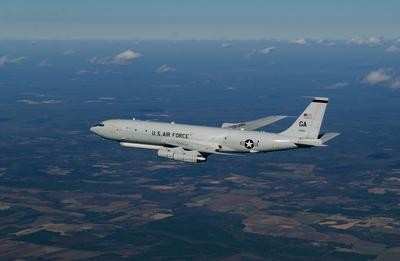JSTARs To Fly With More-Efficient Turbofans
 America's eye in the sky, the E-8C Joint Surveillance Target
Attack Radar System, or Joint STARS, will soon be faster, quieter,
more efficient and more operationally effective with a major engine
upgrade effort now underway at Hanscom AFB in Massachusetts.
America's eye in the sky, the E-8C Joint Surveillance Target
Attack Radar System, or Joint STARS, will soon be faster, quieter,
more efficient and more operationally effective with a major engine
upgrade effort now underway at Hanscom AFB in Massachusetts.
Getting new engines on E-8C test aircraft is a major milestone
for the Air Force, said Col. Jim Lovell, the 751st Electronic
Systems Group commander. "The reliability and fuel efficiency of
these new engines will yield huge benefits to the warfighter --
it's all about improving operational capability," he said.
The E-8C is an airborne battle management, command and control,
intelligence, surveillance and reconnaissance platform. Its primary
mission is to provide theater ground and air commanders with ground
surveillance to support attack operations and targeting that
contributes to the delay, disruption and destruction of enemy
forces.
"We are in the final stages of installing the entire propulsion
pod system -- Pratt and Whitney JT8D engines, Seven-Q-Seven pylons,
instrumentation, and thrust reversers -- on the Air Force
government-owned test aircraft at the prime contractor facility in
Melbourne, Fla.," said Maj. Ryan Knapp, the re-engining program
manager in the 633rd Electronic Systems Squadron. "We are on track
for our upcoming first flight with the T-3 (test aircraft)."
For that to happen, the propulsion pod system had to be removed
from the commercially-owned 707 aircraft previously used to
complete the supplemental test certification program in Mojave, CA
earlier this year. The commercial aircraft was flown to Florida,
where prime contractor Northrop Grumman is removing the pod system
from the Boeing jet and putting it on the T-3.
While the re-engining of the E-8C has been years in the making,
accomplishing this upgrade will yield immediate and significant
benefits to the warfighter.
Among them is the flexibility for the aircraft to depart from
runways of shorter length. Equipped with its current engines, E-8C
takeoffs are currently limited by runway length, fuel load and
environmental conditions. This limitation usually results in an
increased need for tanker aircraft support.
The new engines also increase fuel efficiency by 17 percent,
yielding savings in fuel and -- by extension -- time that's
critical in collecting data. When the aircraft needs to refuel, it
breaks its time "on station," meaning that it has to leave to get
gas and then work sometimes hours to re-establish situational
awareness and communications.
"Every time that happens, the bad guys can potentially be moving
around on the ground without someone watching them, and then the
Joint STARS has to come back and lock on," said Rainy McIntosh,
also of the 633 ELSS. "Those types of breaks in situational
awareness are not going to happen."
Additionally, the new engines will eliminate engine overheating
currently experienced by the operator -- another limitation,
especially during summer months when temperatures can reach well
above 100 degrees. With the current engines in place, the aircraft
could be limited to nighttime operations during those months.
The new engine will allow for 24-hour-a-day and seven-day-a-week
operations, regardless of high temperatures, Major Knapp said.
The first flight of a JSTARS equipped with the new engines is
scheduled for December 17. Contract actions will be negotiated in
early 2009, with a contract award on the horizon a few months
later. This will eventually help solidify the management portion of
the program office.

After the E-8C's first flight with the new engines, the T-3 test
aircraft will undergo an E-8C specific airworthiness certification
test program scheduled to start in early 2009 and last through the
middle of that year.
 Bolen Gives Congress a Rare Thumbs-Up
Bolen Gives Congress a Rare Thumbs-Up The SportPlane Resource Guide RETURNS!!!!
The SportPlane Resource Guide RETURNS!!!! Buying Sprees Continue: Textron eAviation Takes On Amazilia Aerospace
Buying Sprees Continue: Textron eAviation Takes On Amazilia Aerospace Hawker 4000 Bizjets Gain Nav System, Data Link STC
Hawker 4000 Bizjets Gain Nav System, Data Link STC Echodyne Gets BVLOS Waiver for AiRanger Aircraft
Echodyne Gets BVLOS Waiver for AiRanger Aircraft




